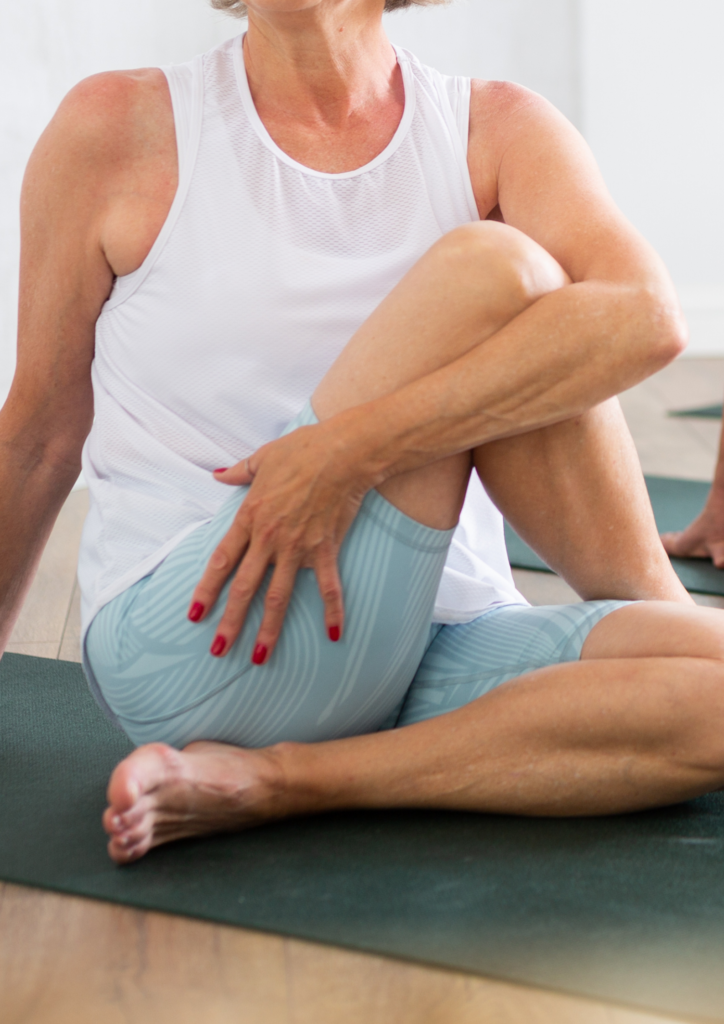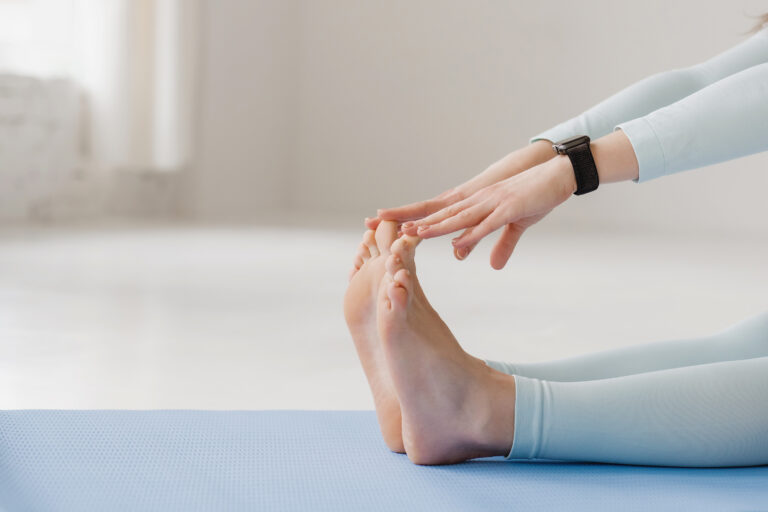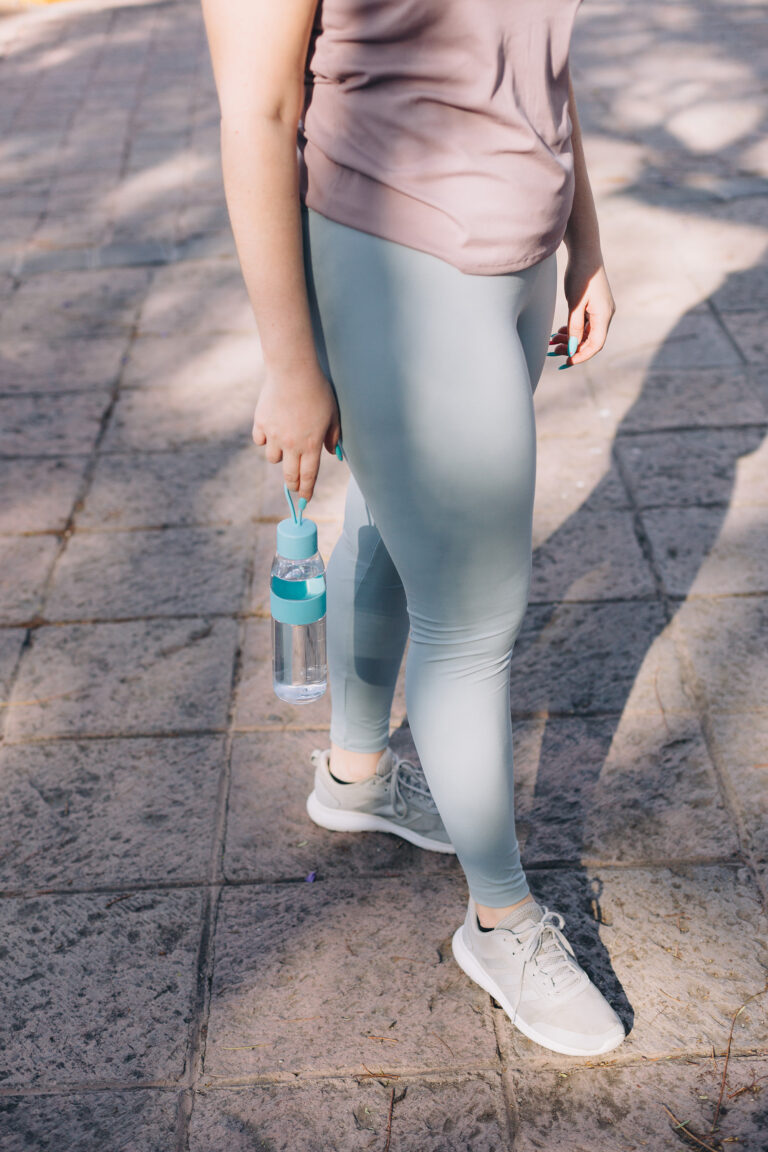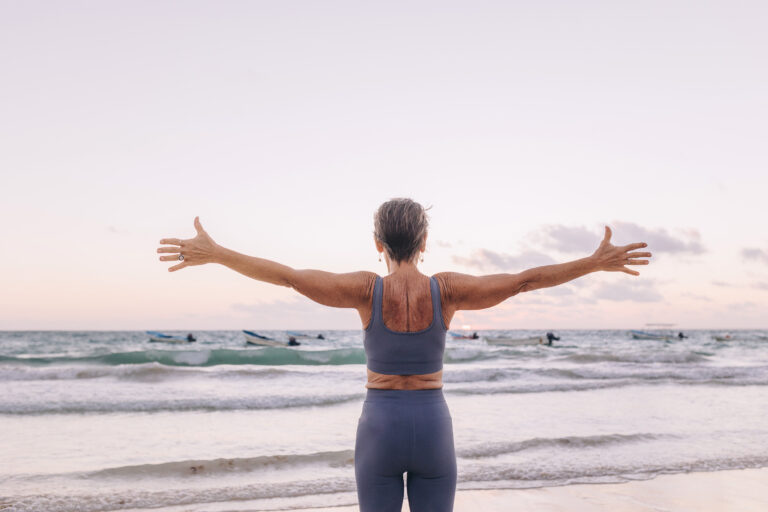If you’re a woman over 50 looking to build strength and stay active for life, the stabilization phase is where it all begins. This crucial first step lays the foundation by improving balance, core strength, and joint stability—helping to prevent injuries before they happen. Skipping this phase and jumping straight into intense workouts can lead to setbacks, frustration, and even pain and injury.
In this post, I’ll explain why stabilization is essential to your routine and how mastering this phase will set you up for long-term success. Then lastly, I’ll give you exclusive access on how to start a workout routine for women over 50 to build strength and confidence!
Just like Pizza Dough, Set Yourself up to Rise
Before we dive in, if you haven’t read the previous blog post Intro to the Phases of Training for Women 50+, take a moment to check it out, please! That post lays the foundation for everything you need to know before getting started, giving you a clear roadmap of what to expect as we move forward into resistance training and cardio exercise.
Today, we’re focusing on the first and most important phase—the Stabilization Endurance Phase.
Phase 1 is all about your starting position, from building muscle for improved balance and core strength, best exercises for aerobic activity, and increased joint stability to prevent injuries and set you up for long-term success.
Skipping this step is one of the biggest mistakes I see when older women begin a home workout routine or weight training program
Now, let’s make sure you’re set up properly to start your fitness journey the right way (ohhh, yes—there IS a right and a wrong way to start!). It’s important to understand that the phases of training are smaller, structured progressions that fit within larger training levels, each designed to build on the previous one for steady, safe improvements within the physical activity guidelines.
Each stage during the different phases of training has a designated purpose that provides you with a systematic approach for progressing toward your workout goals, while addressing specific needs, and keeping safety as a top priority. These stages are highly versatile, allowing women to progress through five distinct, yet adaptable and repeatable training techniques, designed to typically contribute 6 weeks of their time in each phase.
However, outside of Phase 1, some women may not move through the other 4 Phases of training for their workouts, and the duration spent in each phase can be plus or minus the 6 weeks, depending on their current physical activity level, abilities, and goals. Here’s a peek at the different phases within the levels of training:
Here are the 3 different stages of training we’ll be chatting about over the next few blog posts:
Level 1: Stabilization
- Phase 1: Stabilization Endurance – Current Post
Level 2: Strength
- Phase 2: Strength Endurance – I want to know all the details!
- Phase 3: Muscular Development – Build lean muscle? Count me in!
- Phase 4: Maximal Strength – Post coming soon!
Level 3: Power
- Phase 5: Power – Post coming soon!
Let’s train your body to stay steady like a strong tree in the wind!
Level 1 of fitness training consists of 1 Phase of training, which is Phase 1: Stabilization Endurance training.
The main focus of this form of training is to increase muscle endurance and total body stability while developing optimal neuromuscular efficiency and coordination, plus create the habit of regular exercise.
Or in other words, build a strong body that can consistently support you! As a personal trainer, I strongly believe this phase is the most important, and I have a strong feeling other personal trainers would agree. It was mentioned previously that phases are typically 6 weeks in duration. But for some, Phase 1 is a stage that you may be trained in for a longer duration, as it focuses on the entire human movement system and is meant for you to increase the necessary strength to live an efficient life with less pain and limitations.
I have had many women alternate between Phase 1 and 2 throughout their time with me, and they’d continue to benefit and produce positive results such as fat loss, muscle growth, and build the best exercise routine that fit them, regardless of not moving to Phases 3 through 5.
Don’t miss this
If you are just beginning an exercise routine, meaning you’ve never exercised before, or you’ve been out of a consistent routine for 6 or more months, you absolutely need to start in Phase 1.
If I had a woman that was an elite athlete come to me wanting to progress her training game, I would still start her in Phase 1. This way, I can get to know her strengths, muscle imbalances, and body mechanics. If she’s an elite athlete, she might not need to train in Phase 1 for the full 6 weeks, but it is a necessary phase for me, as someone trained in sports medicine, to get to know her body so her strength training and aerobic activity can progress appropriately.
Let’s look at it this way…
Let’s imagine you’re making homemade pizza dough. You know it requires melted butter—but not until step four. The first three steps focus on mixing the dry ingredients first. The same systematic approach goes for your fitness journey—you need to follow the steps in the right order to get the best results. Skipping ahead won’t work. Just like your dough wouldn’t rise properly, your fitness won’t progress properly either.
The Importance of Proper Exercise Form to Achieve Actual Results
Let’s keep digging in and scoop out all the progression details of this very crucial workout phase! The progression level of training in Phase 1 is proprioceptively based, or… creating better movement awareness. This means that difficulty is increased by introducing a greater challenge to the balance and stabilization systems of the body, versus only increasing the load.
Some feel that to increase the challenge level, you need to increase your weight. Which is certainly true, you’ll notice the intensity of that particular weight increase, but there are more appropriate ways to challenge your body specifically in this workout phase. For example:
If you are able to complete a full pushup, you can progress this exercise by performing a pushup on a stability ball.
If your standing band row is feeling easy, progress by standing on one leg while you row.
If you’re able to perform a controlled 10lb overhead press, you can progress this exercise by performing the press on a Bosu ball.
These types of progressions require additional activation from the nervous system and the stabilizing muscles of the shoulders, lower body, and core muscles to maintain optimal posture while performing the exercise. Added weight or load was not needed for these progressions, rather solely focusing on the balance and stabilization mechanics instead.
As you spend time in Phase 1, I can guarantee you’ll begin walking into rooms taller and more confident. Your focus on proper body alignment, proper exercise form and execution won’t go unnoticed in everyday activities. And these variables are hands down my favorite items to instruct to woman, because proper exercise form is crucial for preventing injuries, maximizing results, and ensuring long-term progress.
When movements are performed correctly, women engage the right muscle group, improve their posture, and reduce strain on joints. Poor form, on the other hand, can lead to discomfort, imbalances, and setbacks, especially in older adults and women.
By focusing on proper execution and technique during strength training and aerobic activity, women not only feel stronger but also move more efficiently in everyday life.
It’s common to witness women compensating in a particular area of their body due to years of a muscle imbalance. Phase 1 is the perfect system of training to build muscle mass and work on correcting those tight or weak areas. Without proper body alignment and proper exercise form and execution, you cannot move into the next phase, or Phase 2, as the risk of injury increases and proper exercise execution will not be met, meaning you won’t gain all the benefits from your hard work (and who wants to work hard and see no results-not me!)
If It’s Too Good to Be True, You’re Right
Stabilization and neuromuscular efficiently can only be obtained by having the appropriate combination of proper body alignment, otherwise known as your posture. The human movement system, or your kinetic chain, and your stabilization strength is wildly necessary to maintain proper body alignment and posture.
Stabilization training in Phase 1 provides the needed stimuli to acquire stabilization and neuromuscular efficiency through the use of proprioceptively enriched exercises and progression. In other words, this type of training helps your body stay balanced and move smoothly by challenging your muscles and coordination. It improves control, strength, and posture by using exercises that make you work harder to stay steady.
And to note, neuromuscular efficiency simply means this:
The ability of the neuromuscular system is to enable all muscles to efficiently work together in all planes of motion. Ah, the planes of motion, another goodie to know about! Think of your planes of motion as 3D or imagine yourself dancing to your favorite 2000’s Rihanna song. We live in a 3D world; therefore, we need to be able to move in a 3D state efficiently with little to no pain (can I get an umbrella-ella, eh eh!).
Phase 1 of exercise strength training not only addresses the existing structural deficiencies, but it may also provide a superior way to alter body composition, such as reduce body weight, because all the exercises are typically performed in a circuit fashion. A circuit way of training is performing exercises with a high number of reps with shorter rest periods.
By performing exercises in a proprioceptively enriched environment, such as a controlled, yet unstable exercise, the body is forced to recruit more muscles to stabilize itself. And in doing so, more calories are potentially burned! I said it previously and I’ll mention it again, the Stabilization Phase must be done before progressing into the next phases of exercise strength training. Research has shown that inefficient muscle stabilization can negatively affect the way force is produced by the muscles, will increase stress at the joints, will overload the soft tissues, and eventually will cause injury.
Beware of fitness programs that sound too good to be true—because they are. Anything promising “get fit quick” results or mass-produced weight loss challenges are giant red flags. If your goal is real, lasting success in your fitness journey, steer clear of them. Sure, they sound tempting (diet culture has nailed the art of flashy marketing), but don’t get pulled in. Do everything you can to avoid these quick-fix traps—they’re not designed for your long-term health, they’re designed to sell.
Don’t miss this
Anything promising “get fit quick” results or mass-produced weight loss challenges are giant red flags. If your goal is real, lasting success in your fitness journey, steer clear of them. Sure, they sound tempting (diet culture has nailed the art of flashy marketing), but don’t get pulled in.
Do everything you can to avoid these quick-fix traps—they’re not designed for your long-term HEALTH; they’re designed to sell.
Let’s look at it this way…
Say your workout routine has been on and off most of your life; you haven’t truly stuck to a regimen long-term. But you’re looking to get into better shape now, so you sign up for a 6-week weight loss bootcamp challenge that requires you to jump, lift heavy weights, move with sudden direction change, includes fast-paced cardio, and urges diet restrictions. Such a hasty lifestyle change can actually put your body into shock; similar to the shock you receive if you’ve ever been in a car wreck. Your tendons, ligaments, joints, muscles, bones, and probably even your mind, is on total overload…simply because you did not take the time to welcome yourself into Phase 1 and gain the necessary strength for your body to support you in everyday life and in your exercise progressions.
If you’ve never exercised before, or haven’t been consistently working out for 6 or more months, and you haven’t completed Phase 1 of training, these types of abrupt programs or challenges will do you way more harm than good. Not only can this leak havoc on your body but be detrimental to your diet and emotional state.
Our bodies aren’t meant to go from 0 to 100, and our fuel system and emotional wellness doesn’t respond well if we restrict what we eat. So here it is again, ladies: Don’t. Skip. Phase 1 (and don’t skip meals)!
Phase 1: What to Expect & Why You Need It
Builds a rock-solid foundation
- Before lifting heavier or moving faster, your body needs to be steady and stable—this phase sets you up for success.
Supports joint health and prevents injury
- Strengthening the muscles around your joints makes everyday movements safer and easier.
Improves balance and coordination
- Crucial for reducing fall risk and moving confidently in daily life.
Boosts core strength
- A strong core helps with everything—from picking up groceries to hiking trails to playing with grandkids.
Wakes up underused muscles
- Helps correct muscle imbalances that often show up with age or after years of sitting, working, or caregiving.
Builds endurance and stamina
- Increases your ability to stay active longer—without fatigue taking over.
Goals & Strategies: Your Blueprint to Success for Stabilization Training
Goals:
- Improve postural stability – Create better alignment and reduce strain during daily movement.
- Enhance joint stabilization – Keep joints safe and supported during motion, especially under load.
- Develop muscular endurance – Train muscles to perform over time without fatigue.
- Strengthen the core – Support your spine and balance from the inside out.
- Correct muscle imbalances – Address overactive and underactive muscles to move more efficiently.
- Improve neuromuscular control – Train your brain and body to work together for smoother, safer movement.
- Prepare the body for more intense phases – Build a strong foundation before progressing to heavier loads or power training.
Strategies:
- Unstable Surface Training – Incorporate stability balls, balance pads, or single-leg movements to challenge balance and coordination.
- Slow and Controlled Movements – Focus on proper movement patterns to engage stabilizing muscles effectively.
- High Repetitions, Low to Moderate Resistance – Use bodyweight or light resistance (12-20 reps per set) to build endurance without excessive fatigue.
- Isometric Holds – Incorporate pauses in movements (e.g., holding a squat or plank) to increase stabilization demand.
- Unilateral Movements – Use single-arm or single-leg exercises to improve balance and muscle coordination.
- Integrated Full-Body Movements – Combine multiple muscle groups in each exercise (e.g., squat-to-press) to mimic real-life movements.
- Controlled Rest Periods – Use short rest intervals (30-60 seconds) to maintain endurance focus while preventing fatigue.
- Core Activation in Every Exercise – Prioritize core engagement in all movements to build a strong foundation for stability.
At-Home Exercise Recommendations for Women 50+
Lower Body Stability Exercises
- Single-Leg Balance with Reaches – Stand on one leg and reach forward, sideways, and backward with the opposite foot.
- Step-Ups to Balance – Step onto a box or bench, driving the opposite knee up while maintaining control.
- Wall Sit with Core Engagement – Hold a squat position against a wall, keeping the core tight and posture upright.
- Glute Bridge with Stability Hold – Lift hips and hold at the top for 3-5 seconds before lowering.
- Lateral Band Walks – Place a resistance band around the thighs and step side to side, keeping knees slightly bent.
Upper Body Stability Exercises
- Plank Shoulder Taps – Hold a plank and alternate tapping each shoulder while keeping hips steady.
- Half-Kneeling Single-Arm Overhead Press – Press a dumbbell overhead while stabilizing in a half-kneeling position.
- Bent-Over Reverse Fly with Light Weights – Strengthen the upper back while maintaining a neutral spine.
- Wall Angels – Stand against a wall and slowly raise and lower arms, keeping them in contact with the wall.
- Push-Up Hold – Lower into a push-up and hold just above the floor to engage stabilizing muscles.
Core & Rotational Stability Exercises
- Dead Bug – Lie on your back, extend opposite arm and leg, and keep the core engaged.
- Bird Dog – In a tabletop position, extend opposite arm and leg while keeping the back stable.
- Side Plank with Reach-Through – Hold a side plank and slowly reach the top arm under the body.
- Seated Stability Ball Rotation – Sit on a stability ball and rotate side to side, engaging the core.
Key Training Guidelines:
- Repetitions: 12-20 reps per exercise
- Sets: 2-4 sets per exercise
- Rest: 30-60 seconds between sets
- Tempo: Slow and controlled movements (e.g., 2-3 seconds per rep)
- Frequency: 2-4 times per week
Create a Fine-Tuned Machine: Your Body!
So, there we have it, Phase 1: Stabilization and Endurance Training. An absolute must stage of training that everyone, from the beginner to the alite athlete, must visit. This phase will focus on appropriate body alignment and the stabilization strength necessary to maintain proper alignment.
It increases the strength in your tendons, ligaments, joints, cartilage, bones, muscles, your mind and other human systems to create and build a powerful, fine-tuned, working machine that is your body!
And with all this stabilization talk, it’s time to gradually increase your intensity level by progressing into Phase 2: Muscular Endurance Training. Here, you’ll continue to focus on improving your tendon and ligament capacity through strength training techniques known as supersets, as well as balance exercise framework for stronger core muscles, and moderate intensity activity for your aerobic exercise sections.







